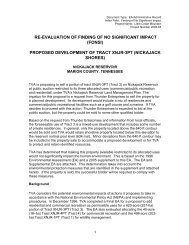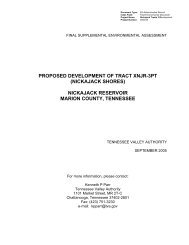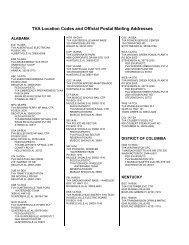Jumpers - Tennessee Valley Authority
Jumpers - Tennessee Valley Authority
Jumpers - Tennessee Valley Authority
You also want an ePaper? Increase the reach of your titles
YUMPU automatically turns print PDFs into web optimized ePapers that Google loves.
On Wings of Leather<br />
Counting noses in the bat Caves<br />
Every year a group of intrepid TVA<br />
biologists set out to take a census of<br />
the population of bats living in the TVA<br />
service area. Working side by side with<br />
their compatriots from the <strong>Tennessee</strong><br />
Wildlife Resources Agency, they fight to<br />
protect threatened species such as the<br />
grey bat (myoits grisescens), which take<br />
shelter in the caves along the <strong>Tennessee</strong><br />
River.<br />
“It’s our responsibility as an agency<br />
to protect this species,” says TVA<br />
Endangered Species Biologist Hill Henry.<br />
“We have counted the bats annually for<br />
the past 15 years because they are a<br />
federally endangered species.”<br />
One such cave sits literally on the<br />
<strong>Tennessee</strong> River, or more specifically,<br />
Nickajack Reservoir. The rectangular<br />
entry opens to what was once a Civil War<br />
saltpeter mine, prior to the construction<br />
of Nickajack Dam. Now flooded with<br />
several feet of water, the cave is further<br />
protected by an iron gate meticulously<br />
hung to keep anglers and recreational<br />
boaters and cavers from entering.<br />
By DAmIEN K. POWER<br />
The reservoir’s shoreline offers dozens<br />
of species of insects an ideal home and<br />
breeding ground, which in turn creates a<br />
veritable buffet for our flying mammalian<br />
friends. Dining on a smorgasbord of<br />
mayflies, moths, neuoptra, caddis<br />
flies and stone flies, thousands of bats<br />
swarm the dusk; zipping along at an<br />
average of 13 miles per hour.<br />
“Inside the cave, closer to where they<br />
roost, we set up thermal cameras<br />
to more accurately capture them<br />
during their emergence,” explains TVA<br />
Terrestrial Biologist Charles Hofer.<br />
Keeping tabs on these small bats has<br />
been an important project, which has<br />
in recent years shown the species<br />
clawing its way back from endangered<br />
into merely threatened territory.<br />
Unfortunately, a new threat looms on the<br />
horizon: white nose syndrome.<br />
A deadly fungus, white nose syndrome,<br />
makes its home on the faces and wings<br />
of several species of bats. Bat colonies<br />
afflicted with white nose syndrome have<br />
Below, TVA biologists and TWRA wildlife managers work near the Nickajack grey bat colony on Nickajack<br />
Reservoir. At right, TVA Terrestrial Biologist Charles Hofer equipped with his headlamp. Right bottom, TVA<br />
Endangered Species Biologist Hill Henry explains the need to monitor the bat population.<br />
seen close to 90 percent mortality rates.<br />
While many bats are migratory, the most<br />
likely cause of this savage plague are<br />
recreational hikers tracking dirt from<br />
infected caves to caves that have not yet<br />
been affected.<br />
“Currently, grey bats have not been<br />
found to have white nose syndrome,”<br />
says Chris Simpson, a wildlife manager<br />
for the <strong>Tennessee</strong> Wildlife Resources<br />
Agency. “However, we are surveying<br />
caves across the state.”<br />
Go to the online Inside TVA to watch a<br />
video of the bat caves. n<br />
Inside TVA | July 2011 | 3<br />
DamIen K. Power










